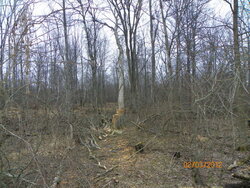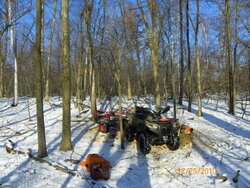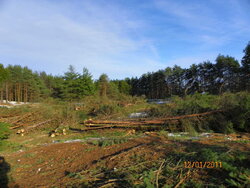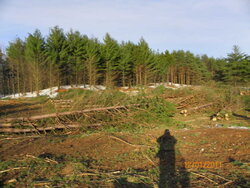When you lose most of it. This is for Backwoods and anyone else who has lost a significant amount of trees such as ash due to disease. What species takes over ? Do you just let it go ? Do you replant saplings ? Carbon you have lost most of your lodgepole pine. What are you doing ?
What happens to your woods ?
- Thread starter TimJ
- Start date
-
Active since 1995, Hearth.com is THE place on the internet for free information and advice about wood stoves, pellet stoves and other energy saving equipment.
We strive to provide opinions, articles, discussions and history related to Hearth Products and in a more general sense, energy issues.
We promote the EFFICIENT, RESPONSIBLE, CLEAN and SAFE use of all fuels, whether renewable or fossil.
You are using an out of date browser. It may not display this or other websites correctly.
You should upgrade or use an alternative browser.
You should upgrade or use an alternative browser.
- Status
- Not open for further replies.
JOHN BOY
Minister of Fire
I hav'nt really lost any tree's due to disease, but the land we purchased was logged many years ago. The fast growing tree's seem to invade more rapidly from what i can tell Like poplar ,sweet gum and pine. Ive got alot of variety here. The oaks , beech, maples and hickory's are making a great comeback,ive been thining out the poplars and pines. Trying to regain a good balance on our land.
I hav'nt really lost any tree's due to disease, but the land we purchased was logged many years ago. The fast growing tree's seem to invade more rapidly from what i can tell Like poplar ,sweet gum and pine. Ive got alot of variety here. The oaks , beech, maples and hickory's are making a great comeback,ive been thining out the poplars and pines. Trying to regain a good balance on our land.
That's the natural progression that you have to work with. Can't easily change the routine of nature, just work with it.
JOHN BOY
Minister of Fire
That's the natural progression that you have to work with. Can't easily change the routine of nature, just work with it.
Exactly, your never gonna be able to stop all the seedlings from coming up. Or stop the tree's from dropping any seed's.
Exactly, your never gonna be able to stop all the seedlings from coming up. Or stop the tree's from dropping any seed's.
Yep, and there is a reason that you don't see your great hardwoods populate a forest from the get-go. It takes time to get the conditions right for many hardwoods to be able to take over, as that happens, the lesser trees (such as quaking aspen) die out on their own since they can't survive in the later stages of the forest's cycle.
There are several hundred (500 or so I believe) acres of truly virgin timber just a few miles from where I work in a nature conservancy. Walking in those woods compared to anywhere else in NEPA feels like I've gone somewhere foreign. Woods like that can't be planted, it takes time.
pen
Thistle
Minister of Fire
Lost a bunch of Red/Black,quite a few White Oaks,few Bur Oaks over the past 30 yrs from either oak wilt,gypsy moth,old age,drought/flooding,various storms & other things.But there's lots of new growth to replace what's lost & I always stomp a bunch of acorns in the dirt every fall too.Not to mention what the squirrels/chipmunks & other wildlife plant also.
I wont be around to see it,but someone else will.That's part of the plan.
I wont be around to see it,but someone else will.That's part of the plan.
fireview2788
Minister of Fire
golfandwoodnut
Minister of Fire
We have lost a ton of Oaks, due mainly to the gypsy moths, now the Ash trees are going. I still cannot see the sky in most places because the other trees take over. I have found that Cherry trees are the main thing that take over here after the Oaks died, but in the main scheme of things, Oaks will win again since they are the most shade tolerant.
osagebow
Minister of Fire
Yep, and there is a reason that you don't see your great hardwoods populate a forest from the get-go. It takes time to get the conditions right for many hardwoods to be able to take over, as that happens, the lesser trees (such as quaking aspen) die out on their own since they can't survive in the later stages of the forest's cycle.
There are several hundred (500 or so I believe) acres of truly virgin timber just a few miles from where I work in a nature conservancy. Walking in those woods compared to anywhere else in NEPA feels like I've gone somewhere foreign. Woods like that can't be planted, it takes time.
pen
well said!
Is the old growth stand Woodbourne up in susq co.? Need to get up there someday. Had a trip planned but had to cancel.
well said!
Is the old growth stand Woodbourne up in susq co.? Need to get up there someday. Had a trip planned but had to cancel.
You nailed it! If you are into geocaching, and plan to make the visit, be sure to check out the multi cache my students placed there. Well worth the walk (drive even).
Message me if you ever make it up, regardless of whether you geocache or not.
pen
Lumber-Jack
Minister of Fire
There are still plenty of healthy lodgepole pine trees out there, and the pine beetle mainly only effects mature trees. And in the areas where there are lots of dead trees there are also lots of little lodgepole saplings that naturally occur, so they fill in the voids pretty quickly when the dead trees are removed.When you lose most of it. This is for Backwoods and anyone else who has lost a significant amount of trees such as ash due to disease. What species takes over ? Do you just let it go ? Do you replant saplings ? Carbon you have lost most of your lodgepole pine. What are you doing ?
The biggest problem is where there are huge areas of the beetle kill, when the trees die they get so dry, these areas become virtual tinderboxes. If they ever catch fire the resultant forest fires can burn so hot that it kind of sterilizes the ground and it can take decades and decades before the trees re-establish themselves. So it's actually a good thing to cut out as much of the dead trees as possible to reduce the forest fire fuel in the forest.
I've noticed that since some of the big oaks were taken from my woods, the beech and maples are really taking off. When looking at the floor of the woods, I have oak saplings but don't see to many past this stage except for the big ones.
ikessky
Minister of Fire
On my parents' land where we hunt, it is all poplar and white pine. If you thin the poplar out, more poplar moves in. There is also a vast area of alder brush that we are trying to thin out. After that, I'm going to try to transplant some maples and ash out there, but I'm not going to hold my breath that they will take.
On my in-law's land where I cut wood, when areas are logged off, usually the first thing back is soft maple.
On my in-law's land where I cut wood, when areas are logged off, usually the first thing back is soft maple.
peakbagger
Minister of Fire
I would do some research to see if the your state has a cooperative extension service or a state forestry department. I expect this question has been asked and they can supply you some good information. In many states, the foresters will come out to your property and assist. I haven't see the devastation caused by the ash borer in person but I expect you have lost the canopy and therefore its similar to a fire event where you get a period of dense growth followed by an eventual transition to whatever dominant tree type emerges. In theory by managing for the eventual growth you can accelerate it. This usually means letting it grow for several years and then doing heavy thinning, but that is site specific. With management you can possibly switch the forest type but it can be tough. Up in northern New England there is a practice called timberstand conversion where hardwood forests are forced to switch over to softwoods as its a better short term economic return. The method basically consists of spraying a clear cut with defoliant that kill broad leaf trees and then planting softwoods if there is not enough natural generation. In your area I expect you would prefer to keep your hardwoods. The other thing to be concerned is if you have local invasive plants, they can sometimes overwhelm a disturbed forest and become dominant. Wildlife does like woods in transition so I would expect you will see more diversity in the critters out in the woods over the next few years.
In general get a professional to walk the woods with you even if you have to pay them.
In general get a professional to walk the woods with you even if you have to pay them.
Standingdead
Burning Hunk
My wooded area is mostly beech and maple. Some of the older trees look like they might be 200 years old. The field perimeters are ash, hickory, poppel mix with hickory being the most dominant. Not much oak. I would say less than 5%. I have a few acre grove of hemlock adjunct to a swampy area. I always wondered if it was planted some time ago. Seems like many more beech saplings than maple overall.
Well, I have been looking at this stuff. I see a nice young oak and then I see a sassafrass towering it and blocking the light. I am going to thin where I think I can help a good hardwood tree. You can do no management and let nature takes it course or you can help it to your benefit with a few changes.
firefighterjake
Minister of Fire
You nailed it! If you are into geocaching, and plan to make the visit, be sure to check out the multi cache my students placed there. Well worth the walk (drive even).
Message me if you ever make it up, regardless of whether you geocache or not.
pen
No kidding . . . didn't know you were into geocaching Pen.
Wood Duck
Minister of Fire
There are always other tree species that fill in when something dies off. I think you are on the right track, Tim. See what sprouts and selectively thin to allow the trees you want to grow a little faster. I'd select a nice mix of the native trees, saving at least a few of every species except the non-native ones. I own only a couple of acres of woods and I am pretty enthusiastic about identifying all the plants here, but I can still go out and find a seedling or two I didn't know I had. Look closely and I bet you'll find some trees you didn't think you had.
osagebow
Minister of Fire
You nailed it! If you are into geocaching, and plan to make the visit, be sure to check out the multi cache my students placed there. Well worth the walk (drive even).
Message me if you ever make it up, regardless of whether you geocache or not.
pen
Will do! What do ya teach? I have 11 and 12 grade kids. Have Ecology, Advanced Bio, Geology and occasionally Astronomy on my plate. I've done the geocaching, but some of my hiking buds are into it.
It's amazing to watch how fast new trees can grow to fill in the empty sky created when large trees fall. Five years ago we lost many large oaks and poplars in a storm (see profile pic). Apart from one huge upturned stump, to look now, you'd hardly know it happened. Saplings that were barely a foot long are are up to 15 feet high now, nearby sickly trees now bask in the sunlight and have more than doubled their canopy size. On the other hand, left unchecked, many less desirable species would come in too, like pokeweed and sassafras.
TE
TE
Two places down from my place there is a 120 acre nature preserve. We took a walk there yesterday. Of course all I could do is look at the trees. Well, I could tell a couple of things. The front part of the property had been fields in its early life. What I saw were smaller type cherry, maple, a few locust. Nothing mature to speak of. In the back is where the real woods began. Now I started seeing beech, oak and big maple. So, I looked to see if there were any of the invasive sassafrass that I have and there were not. I don't have a ton of sassafrass, but I think I need to knock down alot of them.They are competing for light along with the trees I want to preserve. I have so many 25 to 40 foot beech I would like to preserve and also make more light for some oak saplings.
Ashful
Minister of Fire
I live on an old farm, which went from being a working farm to an estate (or "gentleman's farm") in the 1960's. In the time since, several of the cleared fields have been allowed to turn back to woods, and in this case the majority tree in those new wood lots is cedar. It looks odd at first, since we're used to only seeing cedar in hedgerows around here, not in mature woods. Our dominant established forest trees around here are the typical eastern hardwoods, oak, walnut, ash, maple, etc.
These naturally occurring new growth softwoods (eg. cedar) are so unattractive, by comparison. I think I'd be talking to a horticulturalist about plugging in all the oak and walnut saplings I could afford, if I were in your situation of trying to force a reforestation.
These naturally occurring new growth softwoods (eg. cedar) are so unattractive, by comparison. I think I'd be talking to a horticulturalist about plugging in all the oak and walnut saplings I could afford, if I were in your situation of trying to force a reforestation.
Will do! What do ya teach? I have 11 and 12 grade kids. Have Ecology, Advanced Bio, Geology and occasionally Astronomy on my plate. I've done the geocaching, but some of my hiking buds are into it.
This year I have 8th grade physical Science and Advanced Physical Science with Juniors / Seniors. I certainly don't envy your schedule osage!
Backwoods Savage
Minister of Fire
When you lose most of it. This is for Backwoods and anyone else who has lost a significant amount of trees such as ash due to disease. What species takes over ? Do you just let it go ? Do you replant saplings ? Carbon you have lost most of your lodgepole pine. What are you doing ?
First thing that happens sometimes is that we just look at it an want to cry. But then we look around and are in awe of Nature and yes, regrowth is happening. Sometimes not as quickly as we would like but it is coming. The two pictures below are areas that were hit pretty hard. Most of those trees are all in the firewood stack now and the woods really looks thin. In these particular areas there has not been much for new growth but there will be more soon. I've noticed some cherry and birch along with witch hazel and one ash stump has some growth. Probably most of the new growth so far though is soft maple. I'll be interested the next couple of years to how this turns out.


Last December we cut a few thousand pines. It really made things look bare. The cutting was not yet done when these pictures were taken.


I did plant some white cedar last spring but because I was gone most of the month of June and no rain fell, they all died. Just bad luck with the weather as we usually get some good rains in June. However, just a few days ago I walked across the open area in a couple of spots. New pines are coming (mostly whites) but what I really liked was seeing several oaks about 3-4" high along with several cherry.
One corner of our property was mainly popple and we cut all those when we did the pines. It will take a couple years but we expect that area will come back super thick with popple. That is because those grow from the roots of other trees. When you see huge clear cuts, many times those are popple and they do grow fast and thick. Perhaps I may have to cut some of the new witch hazel if other trees come but won't if we don't have to as they provide food for the animals.
As for the sassafras, we have some and like them so we always leave them. Occasionally we will have to cut one because of broken limbs or whatever and I dearly love cutting them just for the smell. Very sweet smell. Wood burns okay but nothing special but we don't mind.
I have made a note that I need to do some trimming around some young beech and shag bark hickory this winter. Those we definitely want to keep healthy if possible.
rideau
Minister of Fire
Dennis -
All that pine cut for thinning, for a harvest, or diseased?
And what did you do with it?
All that pine cut for thinning, for a harvest, or diseased?
And what did you do with it?

- Status
- Not open for further replies.
Similar threads
- Replies
- 28
- Views
- 2K
- Replies
- 22
- Views
- 1K
- Replies
- 1
- Views
- 642
- Replies
- 24
- Views
- 3K

